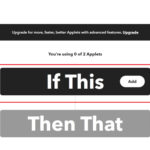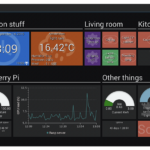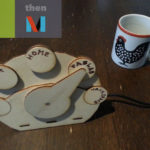Automation has extended from industrial settings to homes and offices, with smart home devices and appliances becoming a part of our everyday lives. One challenge in the automation sector is creating flow and unity between the vast diversity of devices and applications.
Automation has been further affected by various online services such as SaaS (Software as a Service), PaaS (Platform as a Service), and IaaS (Infrastructure as a Service). Among the many SaaS and PaaS platforms, one has risen to prominence, embodying the concept of “Everything as a Service,” or: IFTTT.
IFTTT, established in 2011, is a company that offers an innovative online platform designed to streamline service integration. This platform lets users automate a range of tasks across various sectors, including social media, entertainment, security, smart home technology, health and fitness, weather forecasting, e-commerce, and productivity enhancement.
It unifies an array of online services, proving value to individuals and interconnected devices. With a user base exceeding 18 million, IFTTT simplifies automation without the necessity of coding skills. The platform features an intuitive visual interface that lets users effortlessly create cross-platform conditional statements, automating interactions between smart devices and applications.
In this article, we’ll explore IFTTT in more detail, including how it works with the IoT and smart home automation.
What is IFTTT?
IFTTT stands for “If This, Then That.” It’s an online service platform that lets users create “applets” or “recipes” where an action on one service can trigger an action on an entirely different service. Users create the connections between the two by using simple conditional statements with the help of a visual interface on the IFTTT website.
For example, you can set up an applet that says, “If tomorrow’s forecast predicts rain, then let me receive a notification tonight.” This applet would then automatically send a notification to your smartphone if rain is expected.
IFTTT integrates several services, including social media platforms, smart home devices, email, SMS, cloud storage, and others. This makes it possible to automate many tasks. While users can easily create applets with the help of a visual interface using IFTTT, the platform also offers pre-made options. IFTTT is an excellent solution for streamlining online tasks for people and devices. It’s even possible to automate multiple tasks in a single applet with IFTTT Pro, IFTTT’s new paid service.
IFTTT’s origin
IFTTT was first conceptualized by former IDEO designer Linden Tibbets in 2008. It was officially launched by Linden Tibbets and his brother, Alexander Tibbets, in 2010. The service was unveiled to establish basic automation “recipes” amongst online apps. Soon after, these “recipes” were dubbed “applets.”
In 2012, IFTTT introduced the iPhone app, making the service more accessible to a broader audience. There’s also a version for iPads. In 2014, IFTTT was added as an Android app. It’s since expanded its partnerships, integrating with increasing third-party services and devices, particularly those in the IoT space.
In 2015, IFTTT separated its tasks into three standalone apps: Do Button, Do Camera, and Do Note. A year later, it reverted to a singular app approach and abandoned the “Do” suite. It then also introduced the IFTTT Platform, allowing developers to build and publish applets for broader public use. In 2017, the company launched the “maker tier” for its platform, granting more flexibility and capabilities to individual developers.
IFTTT has continued to expand its partnerships, particularly with IoT manufacturers, to keep pace with the growing ecosystem of smart devices. In 2020, it introduced the “Pro” plan, offering paid subscribers advanced features, including multi-step applets, faster execution times, and conditional logic.
IFTTT has been known for its user-friendly approach to automation, providing non-developers a way to integrate and automate digital services easily. Despite its paid subscription getting mixed reactions at the time of launch, it currently has more than 20 million users.
How IFTTT works
IFTTT is currently one of the most user-friendly online automation services. It functions on a simple “If This, Then That” principle, automating actions (or tasks) based on conditional triggers. There’s no need to code or know any programming language to integrate services or devices. However, developers can build their own web APIs that integrate with IFTTT.
Any framework or programming language that supports web API development can be used with IFTTT, such as Python, JavaScript, Java, Ruby on Rails, .Net Core, and others. IFTTT sends and receives data in JSON format to communicate with these services.
IFTTT is built around “services.” A service can be a web application, a device, a platform, or an online tool. For example, Gmail, Dropbox, Twitter, and smart devices (such as Philips Hue lights), are all considered services.
The services offer triggers and actions. A “trigger” is a specific event or condition in a service that initiates the automated action. For instance, in the Twitter service, a new tweet by a specific user can be a trigger. An “action” is the task that IFTTT performs when the specified trigger event occurs. So, sending an email is an action in the Gmail service.
Users automate the “If, Then” tasks by connecting any two services, where one provides a trigger, and the other provides an action. This “If, then” connection between two services is made using an applet. An applet connects a trigger from one service to an action in the same or another service. It’s essentially the rule or script that tells IFTTT, “If this (trigger) happens, then do that (action).”
For example, an applet might say, “If it will rain tomorrow (trigger), then notify me by email tonight (action).”
Users can use pre-made applets created by other users or services or create custom applets according to their requirements. Once an applet is set up, IFTTT continuously monitors the specified service for the trigger. When the trigger event occurs, IFTTT automatically carries out the corresponding action. This is typically a seamless process that executes in the background. Users do not need to know how the trigger is detected or how the corresponding action is completed.
However, IFTTT might require permission to access certain services like the ones that access your Gmail and Dropbox accounts. With IFTTT Pro, users can set up multiple actions in response to a single trigger. This is useful in building more complex and sophisticated automation.
IFTTT serves as a digital “middle-person,” facilitating interactions between different online platforms and devices that might not otherwise communicate or integrate. It’s a Cloud-based service, and all “If, then” connections are stored on IFTTT’s servers.
The benefit of IFTTT is that non-tech-savvy users can easily use the platform for applications of any complexity without diving into any programming code or script. Nevertheless, most IoT applications still require the programming of a microcontroller or an embedded platform to interact with IFTTT.
What are applets
IFTTT applets are the building blocks of automation on the IFTTT platform. They define how different services interact based on specified conditions. Previously, applets were called “recipes.” The applets connect a “trigger” from one service to an “action” in another service (or sometimes within the same service).
The applets embody the IFTTT principle: “If This, Then That” and can be turned on or off by users as needed. IFTTT continuously polls for its trigger when an applet is active and performs the action when the condition is met.
IFTTT services
There are hundreds of services available within the IFTTT platform. All of these services span various categories. Some of the common categories and services within each are listed below.
1. Social media: Twitter (automate tweets, monitor mentions, track hashtags), Facebook (manage posts, monitor activity, handle photos), Instagram (automate photo uploads, track new posts, manage followers), LinkedIn (share updates, track posts).
2. Smart home devices: Philips Hue (control lighting based on various triggers), Nest Thermostat (Aautomate temperature settings based on conditions or other triggers), Samsung SmartThings (manage smart devices within the SmartThings ecosystem), TP-Link Kasa (control smart plugs, lights, cameras).
3. Cloud storage: Google Drive (save files, create documents, automate backups), Dropbox (automate file uploads, organize files), Box (manage files, create folders).
4. Messaging and communication: Telegram (send messages, photos, or other media based on triggers), Skype (automate messages or calls), Slack (post messages, monitor channels).
5. Blogging and publishing: WordPress (publish posts, monitor comments), Medium (share stories, track publications), Blogger (automate blog posts, track activity).
6. E-commerce and shopping: eBay (track items, monitor auctions), Amazon Alexa (set voice triggers, manage smart home tasks).
7. Security and monitoring: Ring (monitor doorbell activity, record videos), Arlo (manage security cameras, monitor activity).
8. Weather: Weather Underground (trigger actions based on weather conditions, forecasts).
9. Developer tools: Webhooks (integrate with custom web services and apps), Maker Webhooks (create more customizable and advanced interactions).
10. Email: Gmail (automate emails, track receipts, organize emails), Microsoft Office 365 Mail (send emails, organize inbox).
11. Productivity: Google Calendar (create events, set reminders), Todoist (automate tasks, set reminders), Evernote (organize notes, automate note creation).
12. Entertainment: Spotify (manage playlists, track favorite songs), YouTube (automate video uploads, monitor channels).
13. Fitness and health: Fitbit (track workouts, monitor sleep), Withings (monitor health stats, automate health tracking).
14. Others: Location (triggers based on entering or leaving specific geographic areas), RSS Feed (monitor and react to new items in RSS feeds), Date & Time (trigger actions based on specific times or intervals).
IFTTT triggers
In IFTTT, a “trigger” is an event or condition that, when met, initiates an automated action. The specific triggers that are available vary depending on the service being use and its functionality. So, each service may offer a different set of triggers. Some examples of triggers are listed below.
1. Social media: New post, follower, mention
2. Smart home devices: Motion detected, temperature change, light turned on/off
3. Cloud storage: New file in folder, file deleted
4. Messaging and communication: Received message, missed call
5. Blogging and publishing: New published post, new comment
6. Security and monitoring: Camera motion detected, door opened or closed
7. Weather: Rain forecasted, temperature drops or rises
8. Developer tools: Webhook received
9. Email: New email, new email from search
10. Productivity: New calendar event, New task added
11. Entertainment: New song added to playlist, new video uploaded
12. Others: Location entered or exited, RSS feed new item, specific date or time.
IFTTT actions
In IFTTT, actions are the tasks executed when a specified trigger event occurs. Like triggers, actions are dependent on the specific services they pertain to. Examples of actions are listed below.
1. Social media: Post a tweet, Update status, post a photo
2. Smart home devices: Turn on/off light, set thermostat, lock or unlock door
3. Cloud storage: Upload file, create a folder
4. Messaging and communication: Send a message, make a call
5. Blogging and publishing: Publish a post, add a comment
6. Security and monitoring: Start recording, send notification
7. Weather: Send weather report
8. Developer tools: Return Webhook response, run custom code
9. Email: Send an email, mark email as read
10. Productivity: Add calendar event, create a task
11. Entertainment: Play a song, add to playlist
12. Fitness and health: Log activity, set an alarm
13. Others: Send SMS, Set wallpaper, notify
Applications of IFTTT
Various applications across different domains can work with IFTTT. It facilitates most means of digital automation. Some of the key applications of IFTT include the following.
1. Social media automation: IFTTT can automatically share blog posts on Twitter, Facebook, or LinkedIn. It lets users save tweets into Google spreadsheets. With IFTTT, even you can change your profile picture across multiple platforms as you change it in one place.
2. Home automation: With IFTTT, you can automatically turn off smart lights as you leave your home, and it will turn them back on as you return. It lets you get notifications from security cameras as they detect any motion. It can adjust the thermostat based on weather forecasts. You can also automatically start brewing coffee as the alarm goes off.
3. Security and surveillance: IFTTT can notify you when the smart lock is unlocked. It lets you log when doors or windows are opened or closed, and will flash smart lights when a smoke detector is set off.
4. Storage: IFTTT can automatically back-up your photos to storage. It lets you save email attachments to Cloud storage and store screenshots in a specific folder on the Cloud.
5. Notification: With IFTTT, you can receive and automate notifications for specific weather forecasts. You can receive notifications for products that are out of stock or on sale. You can also get notifications for social media posts or forums.
6. Health and fitness: IFTTT lets you log your workouts from a fitness tracker to a Google Spreadsheet, receive reminders to drink water every hour or to take medicines, and track sleeping patterns by recording when you turn off/on smart lights.
7. Productivity: IFTTT lets you save new contacts added on your phone to a Google Spreadsheet. You can archive your email attachments to Dropbox or Google Drive. It also lets you create a to-do list item when you miss a call or set your phone to silent mode during specific calendar events.
8. E-commerce and shopping: IFTTT allows tracking price drops on items you want to buy. It gives you notifications about new products and sales offers from your favorite brands.
9. Entertainment: Using IFTTT, you can play your favorite playlist when arriving home. You can mute your phone during your favorite TV show’s timeslot. You can also change the color of smart lights based on the music playing.
These are only some of the examples of possible applications with IFTTT.
IFTTT for IoT
IFTTT’s ability to connect and automate various online services makes it especially useful for the Internet of Things (IoT). It solves one of the most significant challenges in IoT (i.e., connecting devices and services from different manufacturers using different protocols and platforms).
This platform bridges gaps and allows entirely different devices and services to talk to one another and work together seamlessly. It’s most useful in setting up automation between IoT devices, which is typically technically challenging.
With IFTTT, automation is simple due to its rule-based technique and user-friendly visual interface. This simplifies setting up complex interactions between IoT devices, particularly for non-tech-savvy users. Users can also tailor IoT devices’ behaviors based on personal preferences.
IFTTT can notify users about specific events detected by their IoT devices and log data from IoT sensors into databases, spreadsheets, or other platforms, enabling users to analyze trends and patterns over time. Integrating security-related IoT devices with other services can enhance security. It also integrates smart home devices with various services that enhance their capabilities.
The platform can enhance voice assistants’ capabilities like Amazon Alexa or Google Assistant by creating custom voice-triggered actions involving multiple IoT devices. It can also use a user’s smartphone location to trigger specific IoT actions. Additionally, IFTTT is valuable for several industrial IoT scenarios.
Why IFTTT
IFTTT is high-rated by its users for its simplicity and straight rule-based automation. It automates complex tasks that require technical know-how or would be time-consuming to implement by code.
The platform is easy to follow for non-tech-savvy users. Another reason IFTTT is popular is the diversity of digital services, devices, and platforms it lets users access.
IFTTT cost
IFTTT has three plans. One is a free plan that provides two applets and standard applet speeds. This program allows users to publish applets or create their own and get free mobile app access. It also lets the applets run for an unlimited time.
There is an intermediate Pro plan with a subscription fee of $2.50/month. It lets users create 20 applets and offers a faster applet speed. Users get multi-action applets and exclusive triggers and actions with the Pro plan. The Pro+ plan is the top one available. It offers unlimited applets with AI services, multiple accounts, and Everything-in-Pro. This means users can access developers’ tools and exclusive customer support services. The Pro+ plan is available at a subscription fee of $5/month.
You may also like:
Filed Under: Tech Articles








Questions related to this article?
👉Ask and discuss on EDAboard.com and Electro-Tech-Online.com forums.
Tell Us What You Think!!
You must be logged in to post a comment.